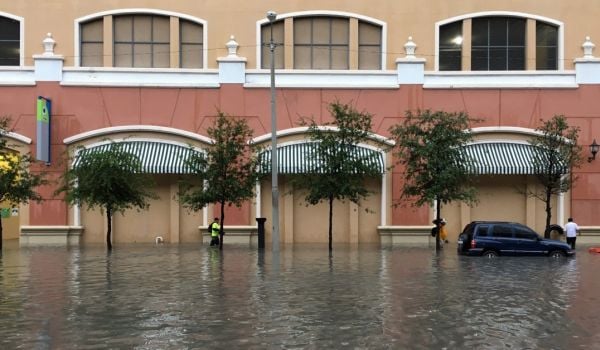At the height of Hurricane Sandy’s storm surge, the tarmac at New York City’s LaGuardia Airport was completely submerged, its jetways extending eerily into what appeared to be a rippling lakebed. When the heaviest winter rains on record drenched England earlier this year, the River Mole topped its banks and shut down half of Gatwick Airport. In Malaysia, a flash flood this spring forced arriving passengers at Penang Airport to wade through knee-deep water. And in 2011, at Bangkok’s Don Muang International, Thai Airways 777s sat wheel-deep in murky water as the worst floods on record in that city closed the airport for over a week.
As extreme weather events become more frequent, the airports of the world — often built on flat, low-lying land that was easy and inexpensive for municipalities to purchase or reclaim — are suffering the perils of their geography. “First and foremost, the history of trade put most major cities on the water,” says Richard Barone, director of transportation programs at New York City’s Regional Plan Association, which has done considerable research on the area’s aviation infrastructure. “And before the jet-age, planes often landed on the water, so as airports expanded, they did so on fill and reclaimed land.” When Newark Liberty International was built on a New Jersey swamp in the 1920s, the city’s authorities invited the public to dump their garbage on the site as infill — to this day, there are 200 bank safes under Newark’s runways, discarded there by a local junk dealer.
Now, the world’s airports’ cheap and easy locations are catching up with them. The U.S.’s National Climate Assessment for 2014 reports, “Thirteen of the nation’s 47 largest airports have at least one runway with an elevation within the reach of moderate to high storm surge,“ and notes that sea-level rise will pose a threat to low-lying airports in the New York metropolitan region, the Bay Area in California, south and central Florida, New Orleans and Hawaii.
Hundreds of other major airports around the world face similar risks. According to a report published by the European air traffic management group Eurocontrol, “in the medium- to longer-term, sea-level rise could threaten runway capacity at more than 30 European airports.”
Planners and elected officials are aware of these challenges. In the wake of Hurricane Sandy, the U.S. government granted LaGuardia airport nearly $40 million to install flood barriers and gravity drains, replace back-up generators, and revamp the airport’s power monitoring and control system. All that, however, might not be enough. Panang Airport underwent a massive $79 million upgrade in 2012 that included a new drainage system and an elevated departure hall. Though the departure hall remained dry during this year’s flash flood, the drainage system failed dramatically.
That’s not to say low-lying coastal airports can’t survive. Amsterdam’s Schiphol Airport lies 13 feet below sea level on reclaimed land that once hosted a massive naval battle. It’s undergirded by more than 150 miles of drainage structures and has a massive pumping system that can quickly expel the water that manages to collect inside the surrounding levees.
Even with such significant investment and planning, however, Schiphol isn’t flood proof — in fact it was forced to cancel some flights due to heavy rains this summer. But it is flood resistant, and planners and officials in Holland have learned to live with the presence of water and planned systems capable of quickly rebounding from flood events, like waterproof electrical equipment and elevated critical systems.
Barone, from the Regional Plan Association, sees learning to live with flood water as a smart response, but cautions that there are risks. “To a certain extent, our airports are going to have to adapt,” he says. “Allowing them to flood during large events might be a good approach, but if frequent storms impact service several times a month, that would be problematic over time.”
He foresees airlines demanding that airports tackle the flood issue, and even choosing hubs based on which ones have done so. “National air space and global air space are really one connected system. If a major hub like New York has weekly delays because of flooding, it’s conceivable that carriers would reroute air traffic or scale back their presence, and that would have profound effects for the region.”
“In the long term,” he says, “there will be a need to look at whether we can build them up, to raise portions to protect them from regular flooding.”
Could major airports be relocated inland? “Yes,” he says, “but costs aside, there’s a catch: convenience plays a significant role in air travel. In the 1970s, when Montreal tried to replace Dorval airport with a larger and more modern structure further from the city, the plan failed because customers and airlines found it inconvenient.” As with flood-proofing, it seems there’s a balance that planners must strike when it comes to airport locations.
And they will need to find it. The FAA predicts “that U.S. airlines will reach the one billion passengers-per-year mark by 2021.” And the International Air Transport Association has noted significant growth in all travel markets, particularly in China and the Middle East, which posted increases of 20.1 percent and 18.1 percent respectively from January 2013 to January 2014.
This kind of demand, mixed with predictions of sea-level rise and more frequent storms, combined with the interconnectedness of international air space, and the needs of an increasingly mobile global economy, poses a serious challenge to nations, municipalities, airlines and customers.

Graham T. Beck has written about art, cities and the environment for the New York Times, The Believer, frieze and other august publications. He’s a contributing writer for The Morning News and editor-in-chief of Transportation Alternatives’ quarterly magazine, Reclaim. He lives in New York City and tweets @g_t_b


















